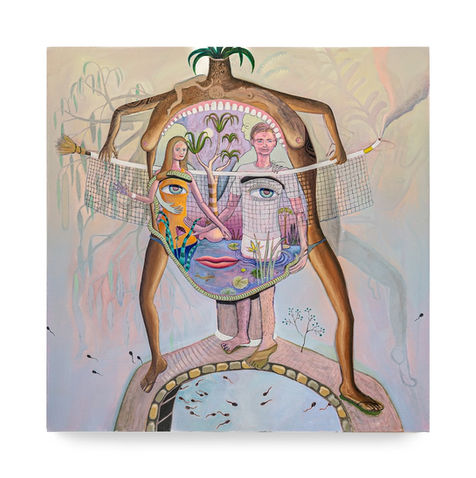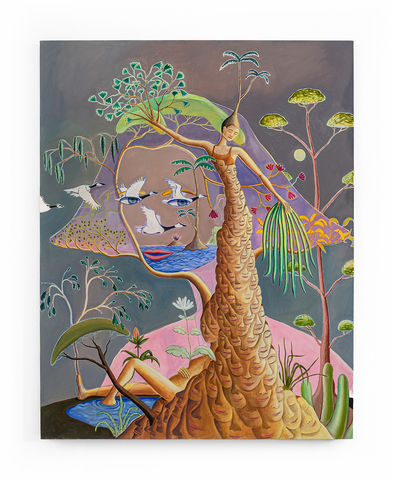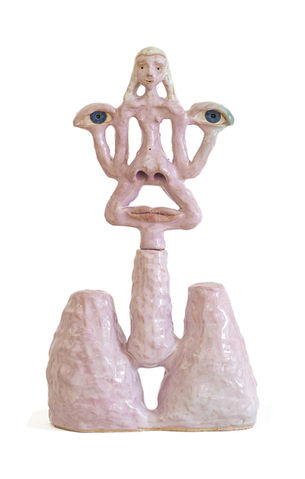Heading 4
The Armory Show | 2025
MARLENE STEYN
05. 09. 25 - 07. 09. 25
Mind Fullness
Here is a woman. Her eyelids are flamingo-feathered. Her mouth wades in a pool of pink. Her nose is the trunk of a tree from which a painkiller hangs like an ornament. Her jaw is a snake. Her hair a crocodile. A moon, yellow as an egg yolk, rests on her cheek like a beauty mark. She is beautiful. Posed. Poised. She is typical of a painting by Marlene Steyn: miscellaneous, but never chaotic—absurd, yet serene.
The influence of surrealism can be felt here. Dalí’s eggs recur across her work. So too do Magritte’s pipes, Man Ray’s musical instruments. For Steyn, the surrealists have served as major inspirations since she was in art school. Over time, she has developed her own repertoire of distinctive symbols, referencing objects that are familiar to her own everyday life: cigarettes, cocktail lemons, socks. Like the surrealists, hers is a “world is broken, but broken beautifully.” This is a question to which the artist often returns during the months that it takes to complete a painting: “How can I break her open?”
Working intuitively —without a sketchbook, without a blueprint, without a reference image or a plan in mind —she draws a line. The line looks like a woman’s back. She paints a woman. Flips the canvas on its side. Now the woman’s back looks like a landscape. She paints grass, flowers, trees. Flips the canvas again. Now the woman’s leg looks like a forehead. She paints a face in profile, smoking a pipe. The pipe’s smoke looks like a cloud. She paints rain. Painting, flipping, breaking—layer by layer, Steyn constructs a portrait as a palimpsest.
This freely associative style of working is a way for Steyn to think about the multitudes that a person contains. In Mindfulness of Mind’s fullness, a woman’s face contains apparitions of many other women––dancing, stretching, kneeling, lounging, sleeping, sliding, falling, touching, thinking, feeling. The implication here is a self built with myriad possibilities. A self that was one way, could become another––all these past and potential selves vying for attention just under the surface of one’s skin. A self in flux. A self in a constant state of transformation.
In this way, Steyn’s work shares an affinity with another branch of surrealism —the often overlooked or misunderstood work of the female surrealists who operated on the periphery of the Global North, from Leonora Carrington and Frida Kahlo to Remedios Varo and Leonor Fini. These are painters who took themselves as subjects, who climbed into themselves and reemerged with strange images —images of women with wheat-hair and thread-hearts. Like their more famous male counterparts, they gleaned from dreams. Unlike them, they dared to lay their own selves on the line, to peel themselves inside out. This is perhaps why these artists have been reappraised in recent years, particularly in the 59th Venice Biennale, The Milk of Dreams (named after Carrington), which tied their work to extremely current questions about definitions of the human in the face of ecological and technological change.
Steyn’s portraits are, in this way, somewhat literal representations of what it means to bear these slippery definitions in one’s mind. One can look at The tadpole’s advantage, for instance, and instantly recognise the sort of thoughts that stream through one’s consciousness on a day to day basis. Tennis this afternoon? I have to sweep the floor. But first I want a cigarette. My husband. I wonder what he’s thinking about. His hand on my hip, or his father? The lily pads are lovely this time of year. I wonder how long they will last. The planet is smoking. The smog is a haze. What colour is the hole in the ozone? Pink? Beige? Tadpoles have no legs for so long and then all of a sudden they’re frogs. Reminds of when I became a mother and then I suddenly ceased to have a head —I was all breasts and arms and legs.
Steyn says that, as she paints them, her figures reveal themselves to her, as friends reveal themselves. “They become real people,” she says. “They tell stories. They zone out.” Because Steyn wants the kind of familiarity that she feels for her figures to be felt by the viewer, she has taken great care to dress them. Steyn’s characters wear scalloped collars, striped shirts, pearl necklaces, beaded earrings, wide-brimmed hats. Fashion is a strong element in this body of work. These make the characters seem identifiable, idiosyncratic. Clothes are, after all, the medium we use to express ourselves to the world, to approximate an internal attitude with an external signifier. To this end, several of the portraits wear ceramic masks. These masks contain other bodies, other selves. For Steyn, the mask is not a cage that conceals but a window into the soul of the portrait. Like clothes, the mask reveals rather than covers.
This combination of painting and ceramic marks a major departure for Steyn’s work. While her practice has always volleyed between the two mediums, ceramics —because they are made more quickly—have often served as Steyn’s method to draw, sketch, doodle, and write notes to herself. Some of these notes —be and be, so full of emptiness—have been used to test glaze and fired into tiles. Other sculptures form playful busts or egg-spatters that harken back to the paintings’ use of surrealist symbols. It is as if the painting-image has leapt out into the world, has become three-dimensional.
The marriage of the two practices creates the sense that one is in the studio with the artist, playing, experimenting, following one’s nose from one image to another. There are few rules: a clay nose can be worn as a barrette; a clay mouth can be fashioned into a third eye; a face can wear a message as a mask. There is a childlike playfulness to this process. And yet the resulting works never feel silly. In fact, they are rather contemplative—not comic, but melancholy. Overall, it is this ability to combine playfulness with seriousness that is characteristic of Steyn’s work.



























